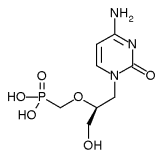A 51-year-old Asian woman with a history of systemic scleroderma underwent bilateral lung transplantation for end-stage lung disease. She was then put on cyclophosphamide as an immunosuppressant. She soon developed hematuria; cyclophosphamide was discontinued and was replaced with mycophenolate. Hematuria workup was undertaken; a bladder biopsy was unremarkable, but urine cytology showed numerous large cells with enlarged nuclei and scant cytoplasm, which mimicked cancer cells. Figure 1 (original magnification × 40) displays the decoy cell surrounded by normal (smaller) urothelial cells. Figure 2 (original magnification ×100) displays a cell with a characteristic homogeneous, opaque, blue-black, intranuclear inclusion. These features are consistent with polyomavirus. Diagnosis was confirmed by positive DNA polymerase chain reaction in the blood and urine for BK virus.
BK virus is a unenveloped, double-stranded DNA virus of the Papovaviridae family and a relative of the JC virus (the etiologic agent of progressive multifocal leukoencephalopathy). It was first isolated in 1971 from a urine sample obtained from a renal transplant recipient. The names of these viruses refer to the first patients' initials. The polyomavirus subgroup of papovaviruses, which includes BK virus, JC virus, and simian virus 40, is a ubiquitous virus with peak seroprevalence in early childhood that ranges from 60% to 100%. BK virus and JC virus are the most studied polyomaviruses in human pathology, whereas simian virus 40 is pathogenic in the monkey and has been implicated in human carcinogenesis.
Polyomavirus is associated with renal and urinary tract pathology. Decoy cells, which are exfoliated into the urine, are prototypes of infectious viral progeny and are released during host cell lysis.1 The initial infection by a polyomavirus occurs in childhood, probably by airways, and is usually asymptomatic. Subsequently, the virus remains latent in kidneys, tonsils, and the central nervous system and may reactivate concomitantly with significant T-cell dysfunction. Infection in immunocompromised patients can be clinically relevant; however, asymptomatic viruria may be detected in 0.3% of individuals without a known history of immunodeficiency. Polyomavirus-associated hemorrhagic cystitis is common in patients following bone marrow transplantation but is thought to be rare among other immunosuppressed patients.2 The kidney, lung, eye, liver, and brain are sites of BK virus-associated disease. Primary BK virus infection is proposed as the cause of a variety of renal diseases, including hemorrhagic and nonhemorrhagic cystitis in immunocompetent and immunocompromised patients. Disease associations range from symptomatic hematuria to hemorrhagic cystitis in recipients of bone marrow transplants and renal allograft transplants. Acute, late-onset, long-duration hemorrhagic cystitis is the type of cystitis that is most often associated with the BK virus, rather than early-onset transient cystitis, which often is secondary to treatment with cyclophosphamide. Hypotheses regarding the association of BK virus with hemorrhagic and nonhemorrhagic cystitis are supported by seroepidemiologic evidence, that is, the increase in immunoglobulins that are specific for BK viral proteins and the circumstantial presence of BK viruria at the time of presentation. BK virus-induced allograft nephropathy may be more common in patients who are treated with certain immunosuppressive regimens. Some supportive evidence exists for an association with tacrolimus and mycophenolate mofetil.1 Reduction in the immunosuppressant dose and use of cidofovir has been associated with better host clearance of virus. Urinary cytology may be the first inexpensive screening and diagnostic test.
References
1. Hirsch HH, Steiger J. Polyomavirus BK. Lancet Infect Dis. 2003;3:611-623.
2. Barouch DH, Faquin WC, Chen Y, Koralnik IJ, Robbins CK, Davis BT. BK virus-associated hemorrhagic cystitis in a human immunodeficiency virus-infected patient. Clin Infect Dis. 2002;35:326-329.
3. Reploeg MD, Storch GA, Clifford DB. BK virus: a clinical review. Clin Infect Dis. 2001:33:191-202.
Jigna C. Jani, MD; Meihua Cuo, MD; NODMD H. Siddiqui, MD
Accepted for publication July 21, 2004.
From the Department of Pathology, University of Illinois, Chicago.
The authors have no relevant financial interest in the products or companies described in this article.
Reprints: ligna C. Jani, MD, Department of Pathology, University of Illinois at Chicago, 446 CMW MC 847, 1819 W Polk St, Chicago, IL 60612 (e-mail: jjani@uic.edu).
Copyright College of American Pathologists Dec 2004
Provided by ProQuest Information and Learning Company. All rights Reserved



